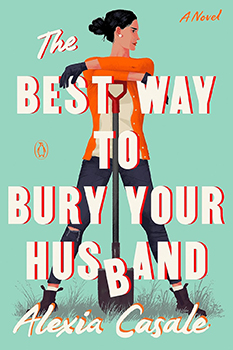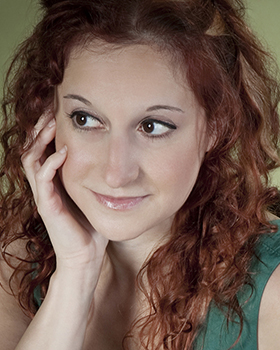

Features Alexia Casale
Besties and Burying Husbands
The Big Thrill Interviews Author Alexia Casale
 Alexia Casale’s new novel, THE BEST WAY TO BURY YOUR HUSBAND, is more than meets the eye. What begins as a pithy, farcical tale of a woman trying to get away with murdering her husband transforms into an empowering story of women supporting women with love, humor, and practical “get it done” action during their darkest moments.
Alexia Casale’s new novel, THE BEST WAY TO BURY YOUR HUSBAND, is more than meets the eye. What begins as a pithy, farcical tale of a woman trying to get away with murdering her husband transforms into an empowering story of women supporting women with love, humor, and practical “get it done” action during their darkest moments.
Casale presents us with four women trapped during lockdown with their abusive husbands. Each suffers a different variety of domestic violence, and each murders her husband when pushed to her snapping point. It’s during the anxious, lost moments of the aftermath these women find each other and form an unbreakable bond while attempting to hide their husbands’ bodies. This isn’t a typical whodunit, but a how are they going to get away with it.
Unbelievably, each woman is someone you can root for. Their stories are sympathetically told without being two-dimensional or cliché. The women in THE BEST WAY have echoes of Knives Out’s Marta and Kitty in Katy Brent’s How to Kill Men and Get Away With It.
The Big Thrill was delighted to sit down with Alexia Casale to talk about the lockdown’s effect on domestic abuse, using humor to encourage reader engagement and courage calling to courage.
Where did you get the idea for THE BEST WAY TO BURY YOUR HUSBAND?
I’m a specialist non-fiction human rights editor with particular interest in male violence against women. [I write for] charities working on the frontline, and they need to figure out how to reach out to victims. [During the pandemic lockdown] they were working with…people who are in so much more danger in their own homes than they would ever be from COVID. That’s the message that has to get out…but nobody wants to hear it. It’s too grim. It’s too depressing.
So, I’m standing in the kitchen one day [trying to] think of something that would make a difference. I can’t do that in nonfiction, but I am also [a fiction] author. Maybe I need to get that tool out of the toolbox because I can’t sit here doing nothing. And this idea just popped into my head. There was Sally. There was the idea for the book.
You use the line, “Courage calls to courage,” as a rallying phrase for Sally and Janey. Where did this line come from, and what does it mean to you?
It’s one of the main suffragette sayings. “The courage calls to courage everywhere, and its voice cannot be denied.” That’s powerful, isn’t it? It was Millicent Fawcett talking particularly about Emily Davidson. (Emily Davidson was a suffragette who died in 1913 after she ran onto Epsom racecourse and was trampled by King George V’s horse.)
[This phrase] is very much about how one woman’s courage is inspiring another woman’s courage. As children [Sally and Janey] aren’t appreciating what it means. It’s this silly thing that this person has said in school; then they learn what it actually means. I quite like that transition. I wanted it to feel like it had its own journey within the book. They arrive at a place where that is a meaningful rallying cry for them that harkens back to its origins.
A major theme in THE BEST WAY TO BURY YOUR HUSBAND is how hope and the support of other women will help you get through even the darkest of times. I love how well you’ve articulated this truth. Is this something you’ve learned through your work as a nonfiction human rights editor?
Yes, much of the time the work is accordingly grim. You’re dealing with the worst things that people choose to do to other people in staggering numbers. The world can seem so beautiful, then you look at your work and think, “What are humans that we can treat so many others this way?” But then you’re in this community of other people, men as well, but largely women who…try and do something about it.
I wanted to have that sort of layering in the relationships between the women. It’s not just about burying bodies; it’s having a cup of tea with each other and being there no matter what. My hope, when I despair, comes from the other women. I wanted that to be in THE BEST WAY TO BURY YOUR HUSBAND because people are more likely to take action if they feel hopeful rather than despairing.
Was your use of humor deliberate? Or is it your usual writing style?
This is only my second book with humor. My last novel was a YA Rom-Com (Sing If You Can’t Dance). The choice [to make THE BEST WAY a humorous mystery] was driven by the way the idea came to me. This horrific situation is purposefully implausible, so you have to make it funny.
THE BEST WAY is effectively a satire. They’re not going to be this many self-defense killings in one five-mile radius, and I’m inviting people to laugh so that they can look at [this grim reality]. People won’t listen if [the writing’s] too grim, but if you make them laugh, then maybe they’ll listen.
You showcase your four women’s cultural differences with deftness and aplomb. What advice can you give other writers who want to include characters whose cultural heritages are different from their own?
Oh, that’s such a great question. It’s an area where there’s mountains to learn about, and I don’t have all the answers, but…I thought very carefully about where I sat relative to what I was doing. But it’s a difficult thing [to tell their stories] when we want to acknowledge what we don’t know but also understand that we all have a lot of similarities. It’s about finding a balance in that.
Hopefully, I’m doing their stories justice, but there are limits. I was lucky enough to have great sensitivity readers. It’s important you listen and try not to be defensive. Defensiveness is a disaster. You should understand you don’t know everything.
THE BEST WAY also features a playlist of empowering music—songs Sally’s son, Charlie, sends her each day of the lockdown. Is this playlist compiled somewhere for those of us who might need it?
I’m going to make one. One of the criticisms that might be made is, “You think all men are bad.” Obviously, I don’t because Charlie is darling. You see he’s a really loving, caring person who is very thoughtful. But I also love music, so it felt very natural [to include it]. I saw this very much as being a film or TV series, and I was thinking, “What would be playing in this scene, and how could I use that?”
Actually, one of my sensitivity readers, who was just absolutely amazing, suggested maybe one of the ways that Ruth and Sally could get to know each other better was to start sharing music as well. So, he gave me a lot of suggestions for Ruth’s perspective that was reinforced by his cultural background. Then, I went through his suggestions, and I picked out the particular songs I felt fit Ruth the best. It was lovely. He gave me something I responded to creatively, and it enriched the story.
What’s next?
I’ve got another YA novel coming that might be titled Not That Kind of Hero. It’s a contemporary Rom-Com that will be out in the UK in the fall. And then there’s going to be a second adult book, hopefully out in 2025.
The Big Thrill Interviews Author Alexia Casale
- Eliza Jane Brazier - August 8, 2024
- May Cobb - August 1, 2024
- Katherine Wood - August 1, 2024

